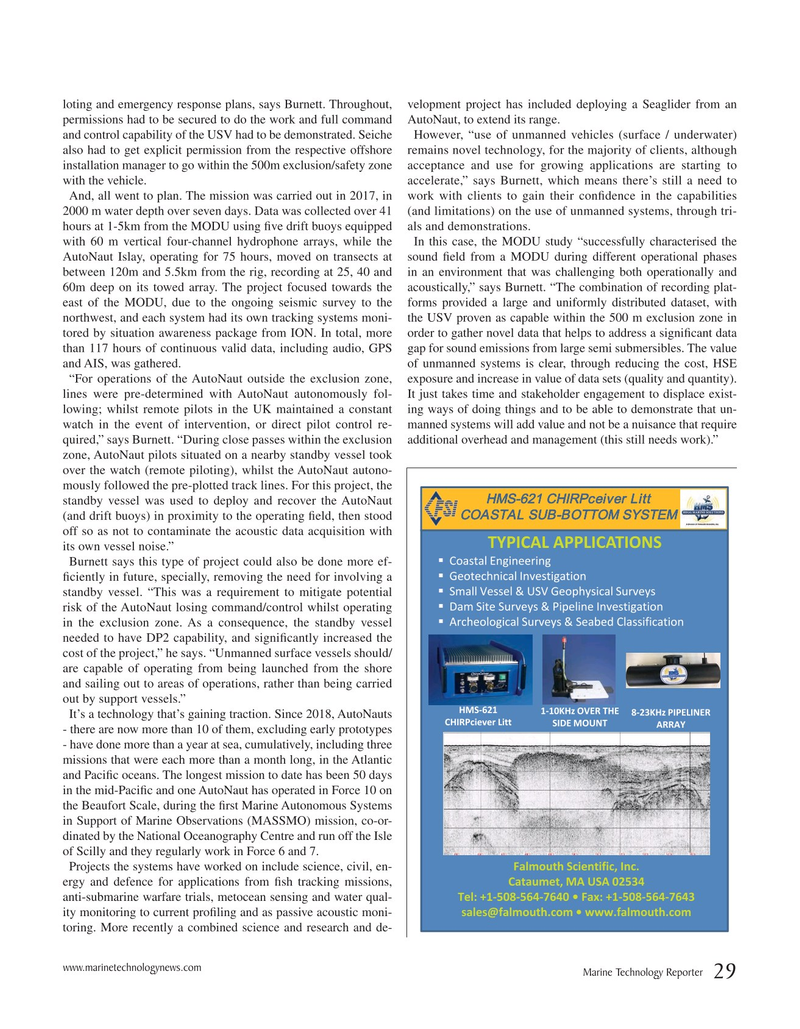
Page 29: of Marine Technology Magazine (April 2020)
Read this page in Pdf, Flash or Html5 edition of April 2020 Marine Technology Magazine
loting and emergency response plans, says Burnett. Throughout, velopment project has included deploying a Seaglider from an permissions had to be secured to do the work and full command AutoNaut, to extend its range. and control capability of the USV had to be demonstrated. Seiche However, “use of unmanned vehicles (surface / underwater) also had to get explicit permission from the respective offshore remains novel technology, for the majority of clients, although installation manager to go within the 500m exclusion/safety zone acceptance and use for growing applications are starting to with the vehicle. accelerate,” says Burnett, which means there’s still a need to
And, all went to plan. The mission was carried out in 2017, in work with clients to gain their confdence in the capabilities 2000 m water depth over seven days. Data was collected over 41 (and limitations) on the use of unmanned systems, through tri- hours at 1-5km from the MODU using fve drift buoys equipped als and demonstrations. with 60 m vertical four-channel hydrophone arrays, while the In this case, the MODU study “successfully characterised the
AutoNaut Islay, operating for 75 hours, moved on transects at sound feld from a MODU during different operational phases between 120m and 5.5km from the rig, recording at 25, 40 and in an environment that was challenging both operationally and 60m deep on its towed array. The project focused towards the acoustically,” says Burnett. “The combination of recording plat- east of the MODU, due to the ongoing seismic survey to the forms provided a large and uniformly distributed dataset, with northwest, and each system had its own tracking systems moni- the USV proven as capable within the 500 m exclusion zone in tored by situation awareness package from ION. In total, more order to gather novel data that helps to address a signifcant data than 117 hours of continuous valid data, including audio, GPS gap for sound emissions from large semi submersibles. The value and AIS, was gathered. of unmanned systems is clear, through reducing the cost, HSE “For operations of the AutoNaut outside the exclusion zone, exposure and increase in value of data sets (quality and quantity). lines were pre-determined with AutoNaut autonomously fol- It just takes time and stakeholder engagement to displace exist- lowing; whilst remote pilots in the UK maintained a constant ing ways of doing things and to be able to demonstrate that un- watch in the event of intervention, or direct pilot control re- manned systems will add value and not be a nuisance that require quired,” says Burnett. “During close passes within the exclusion additional overhead and management (this still needs work).” zone, AutoNaut pilots situated on a nearby standby vessel took over the watch (remote piloting), whilst the AutoNaut autono- mously followed the pre-plotted track lines. For this project, the
HMS-621CHIRPceiverLitt standby vessel was used to deploy and recover the AutoNaut
COASTAL SUB-BOTTOM SYSTEM (and drift buoys) in proximity to the operating feld, then stood off so as not to contaminate the acoustic data acquisition with
TYPICAL APPLICATIONS its own vessel noise.” ?Coastal Engineering
Burnett says this type of project could also be done more ef- ?Geotechnical Investigation fciently in future, specially, removing the need for involving a ?Small Vessel & USV Geophysical Surveys standby vessel. “This was a requirement to mitigate potential ?Dam Site Surveys & Pipeline Investigation risk of the AutoNaut losing command/control whilst operating ?Archeological Surveys & Seabed Classification in the exclusion zone. As a consequence, the standby vessel needed to have DP2 capability, and signifcantly increased the cost of the project,” he says. “Unmanned surface vessels should/ are capable of operating from being launched from the shore and sailing out to areas of operations, rather than being carried out by support vessels.”
HMS-621 1-10KHz OVER THE 8-23KHz PIPELINER
It’s a technology that’s gaining traction. Since 2018, AutoNauts
CHIRPcieverLitt SIDE MOUNT
ARRAY - there are now more than 10 of them, excluding early prototypes - have done more than a year at sea, cumulatively, including three missions that were each more than a month long, in the Atlantic and Pacifc oceans. The longest mission to date has been 50 days in the mid-Pacifc and one AutoNaut has operated in Force 10 on the Beaufort Scale, during the frst Marine Autonomous Systems in Support of Marine Observations (MASSMO) mission, co-or- dinated by the National Oceanography Centre and run off the Isle of Scilly and they regularly work in Force 6 and 7.
Falmouth Scientific, Inc.
Projects the systems have worked on include science, civil, en-
Cataumet, MA USA 02534 ergy and defence for applications from fsh tracking missions,
Tel: +1-508-564-7640 • Fax: +1-508-564-7643 anti-submarine warfare trials, metocean sensing and water qual- [email protected] • www.falmouth.com ity monitoring to current profling and as passive acoustic moni- toring. More recently a combined science and research and de- www.marinetechnologynews.com
Marine Technology Reporter 29

 28
28

 30
30
